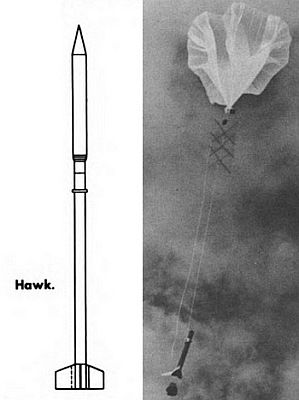Purpose of the flight and payload description
The so called ROCKOON (Rocket-Balloon) technique allowed small rockets to reach higher altitudes by sending it onboard a stratospheric balloon to an altitude of about 70.000 ft where it was fired either by an onboard timer, a pressure switch or by telecommand. The technique was first used in 1952 by Dr. James Van Allen then working at the State University of Iowa.
The main advantage of the rockoon combination was to let the rocket to pass throught the lower and thicker layers of the atmosphere without using its own propulsion power, which then allowed a higher apogee to be reched. The only setback was that once released, the balloons cannot be steered and consequently the rocket's launch direction nor imapct area can be predicted. Thus, for safety reasons, all the Rockoon missions were conducted from small vessels sailing in open waters. This possed an additional advantage as the ships could move with the wind to create a "zero wind condition" ideal to launch the balloons.
The rockoon firings during the 1957 campaign used an improved version of the LOKI vector denominated HAWK. It was a sounding rocket developed by the Jet Propulsion Laboratory for the Army Ordnance Department, manufactured by Grand Central Rocket Co. and Cooper Development Corp. It was designed to carry a 8.5 pound instrument load to an altitude of about 75 miles. It counted with larger fins than the original LOKI design for stability at high altitudes and had a solid propellant rocket motor with 2.200 lbs of thrust. Its total length was 8.3 ft, diameter 3.5 inches and fin span was 1.1 feet. The Hawk was capable of attaining speeds about 3.000 mph, and altitudes of 70 miles when fired from a balloon floating around 70.000 ft.
Details of the balloon flight
Balloon launched on: 10/27/1957
Launch site: USCGC Glacier (WAGB-4) navegando en el Oceano Pacifico (Lat. 40.45º S - Lon. 166.18º O)
Balloon manufacturer/size/composition: Zero Pressure Balloon 26.000 cuft
End of flight (L for landing time, W for last contact, otherwise termination time): 10/27/1957
Landing site: Payload no recoverable
External references
- Loki rocket launches log Jonathan McDowell's website
- Rockoon flights in the Atlantic, Pacific and Antarctic areas IGY Bulletin Nº 11, May 1958, P. 582
5896If you consider this website interesting or useful, you can help me to keep it up and running with a small donation to cover the operational costs. Just the equivalent of the price of a cup of coffee helps a lot.


